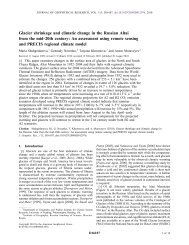Download - GLIMS: Global Land Ice Measurements from Space
Download - GLIMS: Global Land Ice Measurements from Space
Download - GLIMS: Global Land Ice Measurements from Space
- No tags were found...
Create successful ePaper yourself
Turn your PDF publications into a flip-book with our unique Google optimized e-Paper software.
16CHAPTER 2. THE <strong>GLIMS</strong> - PROJECT AND RELEVANT GLACIER CHARACTERISTICScontributions by avalanches, freezing of rain, snow fall and all other processes thatadd material to the glacier. The ablation includes all processes which cause loss ofice and snow of a glacier, e.g. surface and bottom melt, evaporation and calvingof icebergs. The specic mass balance b can be dened as change in mass per unitarea and time and may be seperated in winter balance b w and summer balance b s .The accumulation rate ċ at a given point and given time is the increase of mass perunit area, often expressed as water equivalent. The ablation rate ȧ is the decrease ofmass per unit area. The time integrals starting with t 1 are called accumulation c andthe ablation a. The total accumulation c t and the total ablation a t are integrated<strong>from</strong> t 1 and t 2 . The sum of summer ablation a s and winter ablation a w is can beexpressed as the total ablation a t . The following two equations are <strong>from</strong> Paterson(Paterson, 1994):b = c + a =∫ tt 1(ċ + ȧ)dt (2.1)b n = b w + b s = c t + a t = c w + a w + c s + a s = (ċ + ȧ)dt + (ċ + ȧ)dt (2.2)t 1 t mThe terms t 1 to t m encompass the winter season and the terms t m to t 2 aresummer season. Figure 2.5 shows the denition of the mass balance terms.There are three common ways of mass balance determination. The glaciologicalmethod, the hydrological method and the photogrammetric method.The glaciological method is not only time consuming in measuring the accumulationand ablation but also expensive. The accumulation is measured at the end of theaccumulation period in snow pits. The height and the density of the snow of thelast accumulation period is determined. Optionally also the snow morpholoy andthe snow temperature are determined. The results of these measurements are theannual net accumulation b a . The balance b a of the snow pits in the accumulationarea is than extrapolated to the whole area.The ablation is usually measured using wooden, white painted stakes. On alpineglaciers the stakes are usually anchored in the glacier ice 8 to 12 metres deep. Themelt losses in the ablation area are determined through the height changes of thestakes.The hydrological method requires knowledge of the total precipitation of thebasin (P), the run - o (R) and the loss of ice and snow by evaporation (E). The∫ t m∫ t 2





